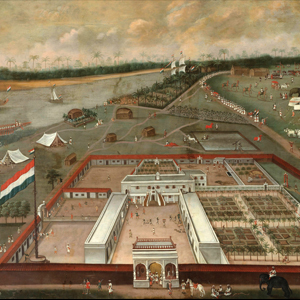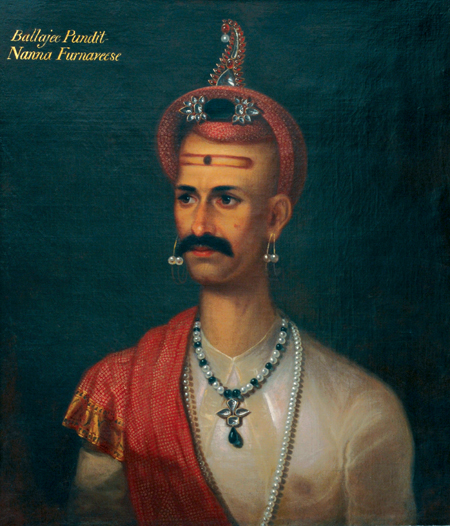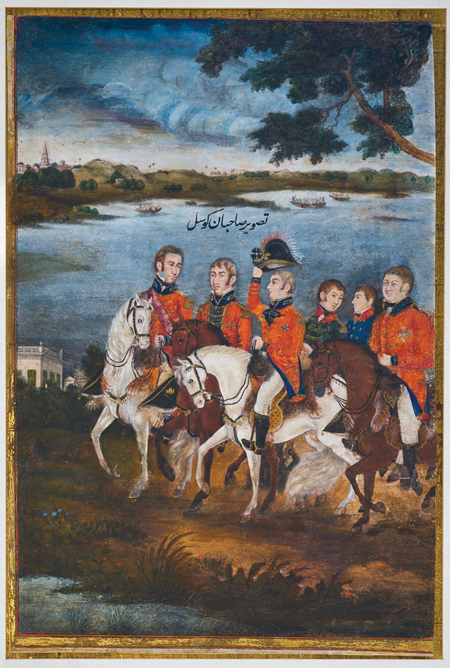Excerpt: The Pillage of an Empire

The British conquered India, we often say. WILLIAM DALRYMPLE, the renowned historian, notes that the reality was more complicated and sinister. “India’s transition to colonialism took place under a for-profit corporation, which existed entirely for the purpose of enriching its investors,” he writes in The Anarchy, his widely praised book.
[Left] Headquarters of the Dutch East India Company at Hughli: CC0 1.0 Universal/Courtesy of Rijksmuseum, Amsterdam
Sir Thomas Roe, the ambassador sent by James I to the Mughal court, is shown before the Emperor Jahangir in 1614—at a time when the Mughal empire was still at its richest and most powerful. Jahangir inherited from his father Akbar one of the two wealthiest polities in the world, rivalled only by Ming China. His lands stretched through most of India, all of what is now Pakistan and Bangladesh, and most of Afghanistan. He ruled over five times the population commanded by the Ottomans—roughly 100 million people—and his subjects produced around a quarter of all global manufactures.
Jahangir’s father Akbar had flirted with a project to civilize India’s European immigrants, whom he described as “an assemblage of savages,” but later dropped the plan as unworkable. Jahangir, who had a taste for exotica and wild beasts, welcomed Sir Thomas Roe with the same enthusiasm he had shown for the arrival of the first turkey in India, and questioned Roe closely on the oddities of Europe. For the committee who planned the House of Commons paintings, this marked the beginning of British engagement with India: two nation states coming into direct contact for the first time. Yet . . . British relations with India actually began not with diplomacy and the meeting of royal envoys, but with a trade mission led by Captain William Hawkins, a bibulous Company sea dog who, on arrival in Agra, accepted a wife offered to him by the emperor and merrily brought her back to England. This was a version of history the House of Commons Hanging Committee chose to forget.
described as “an assemblage of savages,” but later dropped the plan as unworkable. Jahangir, who had a taste for exotica and wild beasts, welcomed Sir Thomas Roe with the same enthusiasm he had shown for the arrival of the first turkey in India, and questioned Roe closely on the oddities of Europe. For the committee who planned the House of Commons paintings, this marked the beginning of British engagement with India: two nation states coming into direct contact for the first time. Yet . . . British relations with India actually began not with diplomacy and the meeting of royal envoys, but with a trade mission led by Captain William Hawkins, a bibulous Company sea dog who, on arrival in Agra, accepted a wife offered to him by the emperor and merrily brought her back to England. This was a version of history the House of Commons Hanging Committee chose to forget.
[Right] Nana Phadnavis by James Wales: By kind permission of the Trustees of Victoria Memorial Hall, Kolkata
In many ways the East India Company was a model of commercial efficiency: one hundred years into its history, it had only thirty-five permanent employees in its head office. Nevertheless, that skeleton staff executed a corporate coup unparalleled in history: the military conquest, subjugation and plunder of vast tracts of southern Asia. It almost remains the supreme act of corporate violence in world history.

Historians propose many reasons for the astonishing success of the Company: the fracturing of Mughal India into tiny, competing states; the military edge that Frederick the Great’s military innovations had given the European Companies; and particularly the innovations in European governance, taxation and banking that allowed the Company to raise vast sums of ready money at a moment’s notice. For behind the scarlet uniforms and the Palladian palaces, the tiger shoots and the polkas at Government House always lay the balance sheets of the Company’s accountants, with their ledgers laying out profit and loss, and the Company’s fluctuating share price on the London Stock Exchange.
[Left] The Duke of Wellington on Campaign in the Deccan: © Private Collection
Yet perhaps the most crucial factor of all was the support that the East India Company enjoyed from the British Parliament. The relationship between them grew steadily more symbiotic throughout the eighteenth century until eventually it turned into something we might today call a public-private partnership. Returned nabobs like Clive used their wealth to buy both MPs and parliamentary seats—the famous Rotten Boroughs. In turn, Parliament backed the Company with state power: the ships and soldiers that were needed when the French and British East India Companies trained their guns on each other.
For the Company always had two targets in its sights: one was the lands where its business was conducted; but the other was the country that gave it birth, as its lawyers and lobbyists and MP shareholders slowly and subtly worked to influence and subvert the legislation in its favor. Indeed, the East India Company probably invented corporate lobbying. In 1693, less than a century after its foundation, the EIC was discovered for the first time to be using its own shares for buying parliamentarians, annually shelling out £1,200 a year to prominent MPs and ministers. The parliamentary investigation into this, the first corporate lobbying scandal, found the EIC guilty of bribery and insider trading, and led to the impeachment of the Lord President of the Council, and the imprisonment of the of the Company’s Governor.
Reprinted from William Dalrymple’s The Anarchy with the permission of Bloomsbury Publishing. Dalrymple is the author of nine books about India and the Islamic world, including Return of a King, which won the Hemingway Award and was shortlisted for the Samuel Johnson, PEN Hessell-Tiltman and Duff Cooper Prizes. He writes for The New Yorker, The New York Review of Books and The Guardian, and is a founder and codirector of the Jaipur Literature Festival.
Enjoyed reading Khabar magazine? Subscribe to Khabar and get a full digital copy of this Indian-American community magazine.
blog comments powered by Disqus











